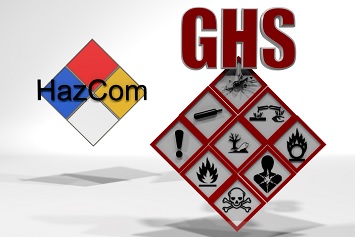The hazard communication standard (HCS) is the second most frequently cited federal workplace safety and health standard, surpassed only by the construction industry’s fall protection standard. The Occupational Safety and Health Administration (OSHA) cited the HCS 4,102 times between October 2018 and September 2019 during 2,276 inspections for fines totaling $5,105,026.

Industries most frequently cited for hazard communication violations include manufacturing, construction, wholesale trade, waste management and remediation services, and accommodation and food services.
For example, OSHA cited manufacturer Champion Modular Inc. for willful violations of the HCS at its Strattanville, Pennsylvania, facility, seeking $94,753 in fines. Employees were exposed to carbon monoxide, combustible and explosive dust, isocyanates, liquid nails, kerosene, respirable dust, and wood dust without required training, according to the agency.
The employer failed to train employees in methods and observations to detect the presence of hazardous substances; health and physical hazards of the substances in their work areas; work practices, emergency procedures, and personal protective equipment (PPE) intended to protect employees from exposures to hazardous substances; and labeling systems and safety data sheets (SDSs) used in the employer’s hazard communication program.
Other employers recently cited for violations of the HCS include:
- Ohio Gratings, Inc., of Canton, Ohio, for failing to compile a list of hazardous substances in the workplace, label a dip tank containing a flammable liquid, maintain workplace copies of SDSs, and provide employee training on hazards in the workplace and details of the company’s hazard communication program;
- Prestress Services Industries of Ohio LLC for 20 health and safety violations, including a serious violation of the HCS for failing to provide information and training on brake cleaners, silica, solvents, and other hazardous substances used at its concrete production plant in Mount Vernon, Ohio; and
- Metal container manufacturer Wright Metal Products Crates LLC for a serious violation of the HCS at its Livonia, Georgia, facility for failing to ensure containers of hazardous substances were properly labeled, tagged, or marked and failing to provide information and training at the time of initial assignment or whenever a new substance was introduced into a work area.
Inspection Procedures Since GHS Adoption
On March 26, 2012, OSHA revised the HCS to harmonize its provisions with the United Nations’ Globally Harmonized Standard of Classification and Labelling of Chemicals (GHS). The GHS is an international model regulation developed by OSHA and regulatory agencies from other countries to ease trade with a uniform system of product labeling and SDSs.
The 2012 rulemaking became effective May 25, 2012, beginning a transition period for labels, SDSs, and training. Chemical manufacturers, importers, and distributors had until June 1, 2015, to transition from material SDSs (MSDSs) required under the 1994 standard to SDSs. Employers had until December 1, 2013, to begin training employees on new label elements and SDSs in the GHS and until June 1, 2o16, to update their workplace labels and written hazard communication programs.
On July 9, 2015, OSHA issued new inspection procedures for the HCS.
Employers must develop a written hazard communication program covering all employees who may be exposed to hazardous substances. OSHA compliance safety and health officers (CSHOs) may cite employers for the lack of a written hazard communication program. The program must include information and procedures for labels and other warnings, SDSs, and training used in the workplace.
At facilities and worksites where temporary workers are employed, both the host employer and the temporary agency are responsible for hazard communication. Both may be cited if temporary workers are not informed about and trained in hazards of chemicals used at the workplace. Temporary agencies must ensure temporary workers understand the elements of chemical labels and have access to SDSs.
The written program may be maintained either on paper or in electronic form. However, employees must know how to access it, and there can be no barriers to access. For example, the written program may not be kept in a locked room.
OSHA inspectors will review the written program during a workplace walk-around, confirming that the program includes a complete inventory of all hazardous substances, methods for informing employees of hazards encountered in nonroutine tasks and the hazards of substances in unlabeled pipes, and methods for informing other employers’ employees at multiemployer worksites, as well as that all employees can and know how to access the program.
Inspectors will check that the labeling section of the program includes a description of the labeling system and alternatives to labeling used for workplace containers, designation of a person responsible for workplace labeling and labeling of shipped containers, and procedures for reviewing and updating labels in the workplace.
The inspector also will check the SDS elements of the program, including:
- Designation of the person responsible for obtaining and maintaining SDSs;
- How data sheets are maintained—in notebooks in work areas, in a pickup truck at a jobsite, or via telefax—and procedures for retrieving SDSs electronically, including backup systems to be used in the event of failure of the electronic equipment and how employees may obtain access to the SDSs; and
- Procedures to follow if an SDS is not received at the time of the first shipment, if it is suspected an SDS is not appropriate, and how to determine if an SDS is current.
CSHOs also will review documentation of training aspects of the written program. Inspectors will look for the designation of a person responsible for training, how training is conducted, procedures for training new employees and training when new hazards are introduced into the workplace, and training for other employers’ employees at multiemployer worksites.
In issuing citations, CSHOs will determine whether the employer has done nothing to comply with the standard; meets the labeling, SDS, and training requirements of the standard but has no written program; or has an inadequate or incomplete program.
Labeling Compliance
Manufacturers, importers, and distributors are responsible for the hazard classification of chemicals they offer. OSHA does not classify or approve the hazard classification of chemicals in commerce. Agency CSHOs will not cite employers for inaccurate or inadequate labels and SDSs provided by manufacturers, importers, and distributors. OSHA will cite employers for removing or defacing shippers’ labels.
CSHOs will check the compliance of labels and SDSs with the HCS during inspections of manufacturers’, importers’, and distributors’ facilities. Hazard classifications used on labels and in SDSs must meet the requirements of OSHA’s standard. Inspectors also will check that manufacturers, importers, and distributors update labels and SDSs with new and significant information about chemicals’ hazards.
OSHA inspectors or their area offices sometimes may consult the agency’s Directorate of Standards and Guidance or Salt Lake Technical Center (SLTC) to assess the accuracy and adequacy of labels and SDSs. Scientists on the SLTC’s Health Response Team have procedures for reviewing the data and hazard classifications used for labels and SDSs.
During inspections of other employers, CSHOs will determine that containers of hazardous substances are labeled and that labels are legible and prominently displayed. Labels must be in English but may also be printed in other languages. Labels must be attached to the immediate container, although fold-back or pullout labels or tags may be used for small or oddly shaped containers.
Stationary process containers such as permanent dip tanks and mixing vessels also must be labeled.
Inspectors will check the product identifier on the label against the SDS chemical inventory in the written hazard communication program. CSHOs also will evaluate the effectiveness of an in-house labeling system by conducting employee interviews to confirm that employees understand the hazardous effects of chemicals to which they may be exposed.
OSHA will cite employers for in-house labels missing information such as the product identifier or hazard description. The agency also will cite employers if stationary containers are not labeled or have labels missing required information and written information is not readily available to employees.
SDS Compliance
CSHOs will confirm SDSs are transmitted to all downstream users. The SDS must be transmitted with the first shipment of a chemical. Manufacturers, importers, and distributors that transmit SDSs electronically must ensure that receiving employers have opted into electronic transmission and cannot require employers to buy any new technology to access SDSs.
The agency will cite manufacturers, importers, and distributors if an SDS was not provided with the first shipment of a chemical or not provided upon employer request. Employers must make a good-faith effort to obtain SDSs if a shipment does not include them or SDSs provided are inaccurate or incomplete.
Employers may seek help from their local OSHA area office to obtain SDSs. However, OSHA will cite employers for a missing SDS if the employers have no documentation of e-mails, letters, or phone calls demonstrating a good-faith effort to obtain a missing, an inaccurate, or an incomplete SDS.
SDSs must be available at mobile worksites if SDSs are kept at a primary location.
During inspections, CSHOs will confirm that employers have an SDS for each hazardous substance in the workplace. They will compare a representative sample of SDSs against the chemical inventory in the written hazard communication program. They also will check that SDSs are current.
OSHA will cite employers if SDSs are not available to other employers’ employees at a multiemployer worksite. The agency also will cite an employer that brings a hazardous substance onto a worksite and does not inform other employers about the substance and availability of SDSs.
Simply providing an employee with an SDS to read does not satisfy the training requirements of the HCS.
Training Compliance
CSHOs will interview managers and employees during an inspection to evaluate compliance with the HCS training requirements. CSHOs use interviews to determine whether employees understand the hazards of chemicals in their workplace.
Employees must be aware of the hazards they are exposed to and understand how to read container labels; find, read, and understand SDSs; and know what precautions to take when exposed to hazardous substances.
During interviews, the CSHO will try to determine whether there is a training program in place and whether employees are trained before their first assignment and trained again when new hazards are introduced in the workplace. They also will check that employees have received training for the employer’s in-house labeling system.
CSHOs will cite employers if there is no training program or training provided is inadequate or even if the employers fail to provide required information about the training program.
Whenever OSHA inspects a workplace where hazardous substances are present, CSHOs will look for a written hazard communication program, container labels, the availability of SDSs, and the effectiveness of the employer’s training program.


